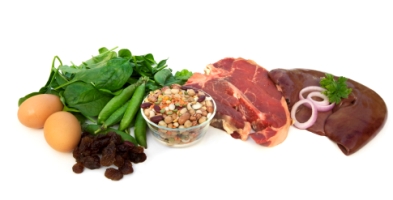 Although iron is classified as a trace mineral, it’s essential for overall health. Many of the body’s functions rely on iron and if you get too little, your body can’t function properly. On the flip side, getting too much can also be detrimental to your health.
Although iron is classified as a trace mineral, it’s essential for overall health. Many of the body’s functions rely on iron and if you get too little, your body can’t function properly. On the flip side, getting too much can also be detrimental to your health.
There are two main types of iron; heme and non-heme. Heme iron is the type found in meat, poultry and fish. Non-heme, on the other hand, can be found in both plant and animal sources. The biggest difference between the two types is how well the body absorbs them. Heme iron is much more easily absorbed by the body than non-heme iron, yet most of our dietary supply comes from non-heme sources. Enriched breads and cereals, lentils, legumes, dark leafy greens, and some dried fruits are foods rich in this type of iron. Although the iron found in these foods is typically harder to absorb, your can improve your body’s absorption rate by pairing your non-heme-rich food sources with a food high in heme iron, vitamin C, citric or lactic acid, and certain sugars.
Most of the body’s iron is found within two proteins: hemoglobin and myoglobin. Hemoglobin is found in the body’s red blood cells while myoglobin is found in the muscle cells. In both, iron helps accept, carry, and release oxygen to the cells of the body. In addition, iron keeps your immune system strong and helps your body produce energy.
Currently, the recommended dietary intake of iron is 8 milligrams per day for men of all ages and women 51 years of age or older. For women 19 to 50 years old, the current recommendation is 18 milligrams per day. For optimum health, it’s important for individuals to get this amount of iron daily. Not getting enough can result in a wide array of problems with iron-deficiency anemia being one of the most common.
Iron-deficiency anemia is a condition where the iron stores of the body are severely depleted and the red blood cells can’t carry enough oxygen from the lungs to the tissues. Essentially, this is an advanced stage of iron depletion. Not eating enough iron-rich foods, not absorbing iron properly, or experiencing excessive blood loss can all ultimately result in this condition.
 Signs and symptoms of iron-deficiency anemia often include extreme tiredness, weakness, headaches, depression, brittle nails, hair loss, paling of the skin, tongue swelling, decreased ability to fight off infections and poor resistance to cold temperatures.
Signs and symptoms of iron-deficiency anemia often include extreme tiredness, weakness, headaches, depression, brittle nails, hair loss, paling of the skin, tongue swelling, decreased ability to fight off infections and poor resistance to cold temperatures.
People who donate blood regularly, suffer excessive blood loss, use medications that interfere with iron absorption, or are pregnant or lactating may be at a higher risk for both iron-deficiency and iron-deficiency anemia. Children, the elderly, and individuals who do not eat meat may also be at higher risk.
Just as it is important to get enough iron, making sure you don’t consume too much is also vital to optimum health. Iron poisoning, or the ingestion of too much iron over a short period of time, often results from ingesting too many iron-containing supplements. This can cause nausea, vomiting, damage to the lining of the intestinal tract, shock, liver failure, and even death in children.
In addition, chronic ingestion of iron at high levels can result in a condition called hamochromatosis which often leads to other serious health conditions such as diabetes, liver damage, and discoloration of the skin. A tolerable upper intake level has been set for healthy adults at 45 milligrams per day and its important for individuals to not go over this amount. At times, a health care provider may prescribe more than this amount for an individual who is suffering from iron-deficiency anemia. Individuals looking to take to take an iron supplement should first speak with their healthcare provider before doing so. Most healthy individuals should be able to meet their daily iron needs through diet alone.
A Few Iron Fun Facts
- Cooking with iron cookware will add iron to your food!
- Spinach and chocolate may decrease iron absorption because of their oxalate content. These compounds bind the iron and keep it from being absorbed by the digestive tract.
Also Read:
